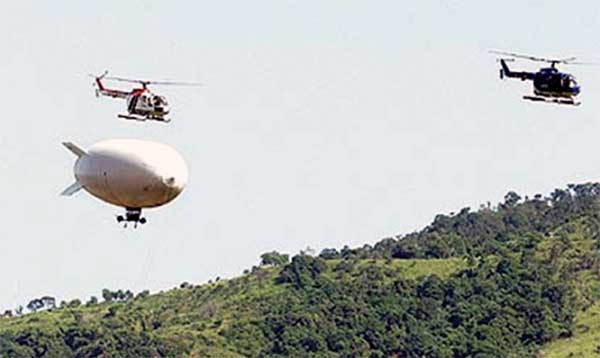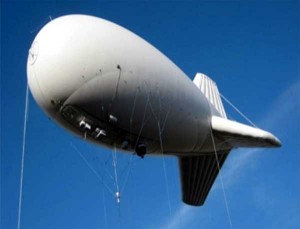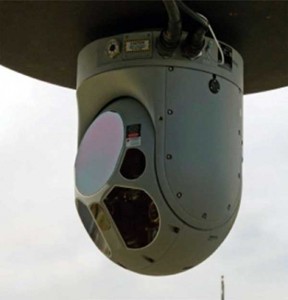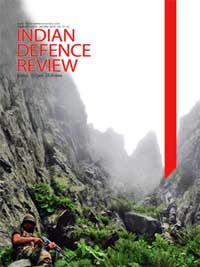Beyond India’s current deployment of large aerostats for wide area radar-based monitoring of border areas, airships, new cargo airships, mid-sized aerostats and tactical aerostats also hold great promise to be cost-effective force multipliers for the IAF, increasing manpower efficiency and simultaneously reducing operating expenses. While unmanned drones also offer many exciting opportunities in military ISR and security enhancement, they often present payload limitations or network operational cost challenges absent with modern unmanned LTA platforms. LTA assets can be cost effective alternatives to larger ISR designated aircraft or multi-role rotary aircraft (HAL Dhruv) in ISR missions, or complement UAVs such as the IAI Searcher II and IAI Heron now in operation, particularly when persistent and regional ISR mission support is required.
The application of aerostats for defensive area monitoring, or mobile airships for ISR patrol, can deliver mission effectiveness and cost containment while freeing IAF assets for other tasks…
The benefits of Lighter-Than-Air (LTA) platforms should be considered carefully and broadly as part of a holistic approach to strengthening the air defence environment in India, deploying force multipliers for the IAF and enhancing offshore patrol capabilities. Traditional piloted ISR aircraft such as Phalcon AWACS remain expensive to acquire, operate and maintain while slower or stationary, helium-filled airships and aerostats present manpower and cost efficient alternatives for rapidly delivering persistent elevated situational awareness supporting diverse missions.
Beyond India’s current deployment of large aerostats for wide area radar-based monitoring of border areas, airships, new cargo airships, mid-sized aerostats and tactical aerostats also hold great promise to be cost-effective force multipliers for the IAF, increasing manpower efficiency and simultaneously reducing operating expenses. While drones also offer many exciting opportunities in military ISR and security enhancement, they often present payload limitations or network operational cost challenges absent with modern unmanned LTA platforms. LTA assets can be cost effective alternatives to larger ISR designated aircraft or multi-role rotary aircraft (HAL Dhruv) in ISR missions, or complement UAVs such as the IAI Searcher II and IAI Heron now in operation, particularly when persistent and regional ISR mission support is required.
“The application of aerostats for defensive area monitoring, or mobile airships for ISR patrol can deliver mission effectiveness and cost containment while freeing IAF assets for other tasks,” explains John Kiehle, Aeros’ Director of Communications adding, “Each LTA platform can provide enhanced capabilities and/or cost benefits to the IAF’s other regional operational commands (CAC, EAC, SAC, SWAC, WAC) as can Aeros’ ground-based solutions for elevated observation.”
Airships are typically piloted but have potential for future unmanned operations…
For a better understanding of capabilities enhancement for the IAF, now and in the near future, we will explore and illustrate the types of LTA assets and their expanding applications and benefits with the help of Aeros, a leading FAA-certified LTA manufacturer based in Los Angeles. Founded more than 25 years ago, the Aeroscraft Corporation (Aeros) has achieved multiple FAA airship type certificates and operates with an FAA Production Certificate while featuring a product line that includes advanced airships, tethered aerostats and the Aeroscraft cargo airship now in development.
Strengthening India’s Air Defence Environment and Offshore Patrol with LTA Assets
There are three main categories of Lighter-Than-Air (LTA) assets, and each can further strengthen the air defense environment in different ways: unmanned and stationary Aerostats (tethered); mobile, piloted Airships (blimps), and new heavy-lift Cargo Airships that will enter service in the coming years (variable buoyancy vehicles).
• Aerostats: Unmanned and tethered, aerostats are aerodynamic LTA platforms that provide cost-effective ISR support like a low-flying satellite system, but are much cheaper to launch and operate. Aerostats provide a constant ‘eye in the sky,’ providing persistent, wide-area coverage, particularly where topography or other factors limit land-based coverage. They can lend situational awareness to other air and ground support personnel, and are ideal when rapid deployment and persistent monitoring for days, weeks, months or years may be required. Large aerostats have fixed stations and can stay aloft for nearly a month between service maintenance, and often carry surveillance radar for long range detection and Precision Track and Illumination Radar (PTIR) to best focus on items of interest, as well as equipment for multi spectral HD imaging, and/or Communications and Signals Intelligence (COMINT & SIGINT) equipment.
IDR readers are likely to be aware of India’s current use of large 71 meter aerostats (from Rafael/TCOM) now monitoring border areas, or may also be familiar with the Akashdeep aerostat system developed locally during the last few years by Aerial Delivery Research and Development Establishment (ADRDE) under the Defence Research and Development Organisation (DRDO). However, readers may not be aware that aerostats similarly aid persistent monitoring of America’s southern border and the area surrounding the US capital, supporting threat identification, immigration enforcement and national security because of their vigilance and cost-effectiveness.
For the military, this new generation of airships has the potential to revolutionise the future of intra-theatre airlift…
• Airships: Also known commonly as blimps, airships are helium-filled multi-role aircraft often associated with event advertising and broadcast roles. However, airships provide a highly mobile, flexible, quiet and stable elevated sensor platform with slow-loiter and extended time-on-station capabilities that can service a variety of military and government missions.
Airships provide flexible payload integration options for advanced radar systems, high-definition multi-spectral imaging (electro-optics, thermal imaging) electronic intelligence, communications equipment or other payloads. They are typically piloted but have potential for future unmanned operations. For example, Aeros’ latest ISR airship, the 40E ‘Sky Dragon,’ can deliver 24-hour imaging or monitoring, has a range exceeding 500 km, and onboard workstations for analysis or HD downlink for remote operation and data acquisition.
• Cargo Airships: Modern cargo airships will support strengthening the air defense environment and force multiplication for the IAF in a markedly different way than traditional airships and tethered aerostats. An emerging LTA category being pioneered by Aeros to enhance military and commercial logistics, cargo airships are not currently in service, but should soon supporting logistics and humanitarian missions. Infrastructure independent cargo airships are likely to support commercial and economic development activities as well as military roles, helping support current air cargo growth in India; in 2013-2014, all operational airports in India handled two million Metric Tonnes (MT) of cargo (1.4 million MT international and 0.8 million MT domestic), registering a four per cent growth over the previous year.
For the military, this new generation of airships has the potential to revolutionise the future of intra-theatre airlift, greatly increasing heavy cargo lift capability, reducing the logistics footprint in theatre, reducing dependence on airbases and ports, reducing the effectiveness of anti-access strategies employed by adversaries, and radically changing the hub and spoke logistics structure to one of point-to-point delivery. The cargo airship’s introduction to global logistics will reduce operational constraints on future heavy-lift, radically reduce energy use for aircraft operations on a tonne/mile basis, permit high-payload operations directly into austere locations with little infrastructure, surpass by several times the speed of fast sealift, and reduce the need for intermodal transport to move cargo from origin to point-of-need, with corresponding reduction in delivery time.
Modern cargo airships have nearly three times the fuel efficiency as air transport alternatives, and can land in very remote locations…
So exciting is their potential, that the US Congress recently created a new caucus to support the accelerated deployment of cargo airships. The bi-partisan caucus is Co-Chaired by Rep. Tom Rooney (R-FL) and Rep. Brad Sherman (D-CA), and has just started working to hasten the take-off of the cargo airship industry, an infrastructure independent mode of transportation, in support of military, economic, national security, diplomatic and environmental objectives. The chairmen explained their motivations for leading the caucus, stating:
“Modern cargo airships have nearly three times the fuel efficiency as air transport alternatives, and can land in very remote locations,” said Congressman Brad Sherman. “They have enormous potential to enable economic development opportunities and accelerate export logistics, expand US capabilities in disaster relief response, and drive greenhouse gas reductions in aviation.”
“The recent advances in airship technology are exciting, and the Caucus will help illustrate the breadth of benefits enabled by cargo airships’ efficient and infrastructure independent operations, including benefits to military operational tempo and mission flexibility, enhanced delivery capability, and operational cost savings,” said Congressman Tom Rooney.
Cargo airships are an exciting innovation because cargo airship utility has been historically hindered by external ballast exchange requirements, as well as lack of Vertical Take-off and Landing (VTOL) flight capability, slow speed, and non-rigid structural design that has limited payload capacity, aerodynamic loading (speed) and propulsion flexibility. Essentially you needed a large volume of lead or sand bags pre-deployed and loaded at destination before heavy cargo removal, to keep the helium-filled vehicle grounded. Aeros’ validated self-ballasting design for the 66-tonne and 250-tonne Aeroscraft address these limitations, while combining many of the flight attributes and benefits of fixed-wing, rotary and traditional LTA vehicles to move cargo directly or flexibly to new destinations independent from infrastructure.
The Indian Air Force currently employs aerostat-based radar systems for border monitoring on 70M class fixed systems…
• Aeros’ Aeroscraft: The Aeroscraft features internal rigid structure and onboard buoyancy management technology called Control-Of-Static-Heaviness (COSH), to control lift in all stages of air or ground operations, enabling both VTOL and off-loading of cargo/payloads without airships’ traditional requirements for external ballast exchange. The innovative infrastructure independent airship is poised to launch new category of freighter aircraft capable of transporting heavy payloads to remote locations and providing flexible, point-to-point air cargo delivery for military, commercial and humanitarian applications.
Airship Missions
The flight performance characteristics of airships and their flexible payload integration can cost-effectively service a variety of military and para-military missions strengthening the defence environment, both onshore and offshore, including:
Primary: Onshore/Offshore Airborne Early Warning (AEW)
• Communications, Intelligence, Surveillance, Reconnaissance (C4ISR)
- Air & Surface Wide Area Monitoring: supports multi-mode radar w/ Air-to-Air MTI/ GMTI. From altitude ceiling, airships can track targets up to 141 miles (228 km) LOS, 360 degrees, observing over 62 thousand square miles at a time.
- High Definition multi-spectral imaging: Electro-optic and Infra Red (EO/IR) – 1080P HD-SDI
- Communications & Intelligence: relays, jammers, Signals Intelligence (SIGINT) and traffic analysis (COMINT & ELINT); ECCM
Other Onshore Missions
- Customs/Border : improved line of sight visibility in urban/rural areas for cost effective monitoring and over-border observation
- Law Enforcement: airborne surveillance and communications for increased ground unit effectiveness; command policing assistance in situations of widespread civil unrest
- Event Security and Safety: quiet and persistent area observation and documentation with benign advertising/broadcast associations
- Infrastructure monitoring: cost-effective patrol of high value facilities, pipelines, and potential terrorism targets
- Survey/Ground Mapping: Spot SAR/Strip SAR; cost-effective geophysical survey, hydrographic and cartographic work, wildlife and archaeological surveys
- Area Control and Coordination: airborne command and control; coordinating the actions of agencies and responders when natural disasters, fires and other events disrupt surface communications
- Ground Radar Calibration (GRC): more cost-effective initial and repeat calibration asset while freeing other aircraft for operations








